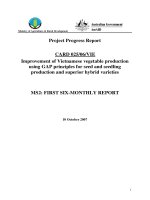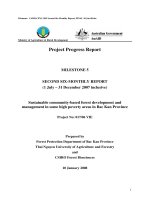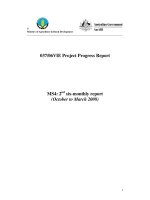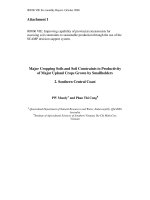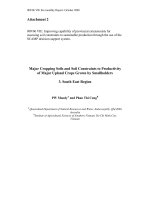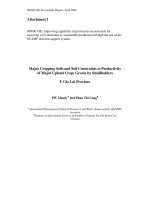Dự án nông nghiệp " Milestone 9A Competency Assessment - Monitoring & Evaluation " doc
Bạn đang xem bản rút gọn của tài liệu. Xem và tải ngay bản đầy đủ của tài liệu tại đây (1.03 MB, 32 trang )
Ministry of Agriculture & Rural Development
010/06/VIE
Training and Extension
Milestone 9A
Competency Assessment - Monitoring & Evaluation
March 2010
2
Abbreviations
ADG
AI
Average Daily Growth Rate
Artificial Insemination
BCFRC Bavi Cattle & Forage Research Centre
Co Company
Demo Demonstration
DM Dry Matter
FA Farmer Association
FFS Farmer Field School
g Gram
Ha Hectare
Kg Kilogram
KjME Kilojoules of Metabolisable Energy
Ltd Limited
LWT Live weight
ME Metabolisable energy
PA Per Year
ToT Trainers of Trainers
W/S Workshops
WM Wet Matter
Yr Year
3
Milestone 9 – Objectives 2 & 3
Competency Assessment & Monitoring & Evaluation
Overview
The Nghia Dan District is a very large district and part of the project area has little technical
support for animal husbandry. A new sub-district is being formed that will include the project
site; however, this will have little effect on extension for a number of years.
One weakness of the project is the lack of technicians (trainers) to extend the project
technologies around the district. The use of key farmers, demonstration sites and farmer
technicians has been effective, but their contact is limited to nearby farmers or relatives in
nearby villages. The concept of Farmer Field Schools (FFS) and farmer discussion groups
should be promoted in the district.
Of the nine key farmers, three have been excellent at taking up the technologies and
embracing change and the challenges; four have been slower to adopt the technologies, one
has not been active and another has withdrawn due to ill health.
The 19
th
May Company has lacked the structure or skill base to be able to develop a model
farm. This is disappointing as it was hoped that the 19
th
May Company would have provided
the district with a larger scale model as well as a supply of genetic material in the future.
The Company was developing some animal husbandry skills and had developed a 34 cow
dairy herd with 16 milking cows; but in 2010 handed its dairy development to the HT Dairy
Processing Co with the development of a 6,400 cow farm.
The nine key farmers have been active in involving their local farmers in training and
especially in project activities such as animal breeding with village bulls and detection of
cows being “in heat” for successful mating, sowing and harvesting new pasture species and
silage making. The key farmers were supplied with small forage choppers, small silage
tanks, new species of pasture; eartags for their cattle and weigh bands to record cattle
liveweights. Five of the key farmers have been active in being key speakers at project
workshops around the area at district level. This has been one of the best aspects of the
key farmers programme. Five key farmers were taken on a field trip to Thailand in April
2008. This was very effective in encouraging the key farmers and demonstrating the
opportunities to developing beef production.
Many of the new technologies were completely new to the region and it was very important
to trial the technologies and make sure that they were robust and suitable.
Mullato II and Ubon paspalum had never been
planted in Vietnam at the beginning of the project.
The use of Napier grass and Rhuzi as a forage
was just starting. Silage had never been made in
the 3 project villages. Cross breeding of cattle
was new and farmers had little or no
understanding of nutrient balancing.
4
The project (through the project farmers) now have working examples showing the
effectiveness of some very important key developments i.e. bi-product silage, new pasture,
crossbreeding and increased cattle growth rates). These examples are only now reaching
for wider implementation and adoption. For many farmers new pastures (hybrid Napier
(elephant grass) and green-feed maize are providing good feed supplies across nearly the
whole season, that they feel comfortable managing without silage.
Trainers of Trainers (ToT’s):
The project trained three ToT’s. The key ToT has been Mr Toan; a senior member of the
BCFRC with a strong academic background in his position. Mr Toan developed training
material and build on his previous experience.
Knowledge developed by Mr Toan has been the experience with the new pasture species as
well as providing training to both farmers and technicians in beef and dairy farming and
animal husbandry management. Toan has managed the delivery of the village bull project
and worked closely with the project key farmers, the distribution of pasture seed to project
and non-project HH, and the distribution of pasture tillers for transplanting in two new non-
project villages (names xx). He has taken responsibility in arranging farmer training at Bavi
Mr Ly is the Senior Extension Officer in the Nghe Dan District. Mr Ly is based in Thai Hoa
Township and has a team of six technicians and is responsible for all aspects of agriculture,
with 2 technicians on animal and forage extension in the District. Mr Ly and his team have
worked mostly with non-project villages, introduced project technologies, and new pasture
species are now established on 26 farms. In 2009 they had 30 village training seminars to
1060 farmers of which 1/3 was pasture and livestock focused.
Mr Hoa is a senior animal breeding technician from BCFRC that was seconded to the project
for 6-months in 2007 to provide training in animal breeding, AI and forage management. He
was effective during his 6 months assignment of living and working in the village.
Table 1 provides a summary of the number of farmers receiving and adopting technology
from TOT’s.
5
Table 1. Trainer-of Trainers (TOT), technology, number of farmers receiving and adopting
technologies.
Person & Area Technology No. Farmers
knowledge
transfer
No. Farmers adopting
new technology
Toan Village bull 5 HH as bull
managers
4 using & keeping
records
Cross breeding 120 75% adoption
Animal health 80 70% adoption
Silage 20 30% adoption
New pastures 60 75% using 1 year later
Feeding
guidelines
Ly (Thai Hoa) New pastures 38 provided
seed
18 continued after 2
years
Hoa AI & breeding 45 (mostly non-
project)
40% conception rate
Nutrition na na
Key Competencies Transferred to ToT’s:
1. Introduction of new training methods, i.e. use of Powerpoint, participatory training and
the use of a practical demonstrate approach
2. Use of demonstration training techniques, on farm demonstration and practical
workshops
3. Management of project coordination and farm management systems
4. Introduction to adult training methodologies
5. Introduction and evaluation of new pasture species
6. Introduction to silage technologies
7. Training in nutrient balancing and the use of bi-products
8. Undertaking training technicians in animal breeding concepts and methodology
6
Trainer of Farmers:
Farmer Association leaders in each village
The Farmer Association (FA) leaders do not have strong depth in animal husbandry and do
not fill the role of farm advisors; their role seems more like a coordinator of activities; they
could fill the role of coordinator and facilitator for FFS.
Technicians from the 19
th
May Company,
The technicians at the 19
th
May Co are now totally committed to the new T&H international
company and are not available as ToT’s within the beef project. These technicians over time
will increase their knowledge of animal husbandry and dairy production.
Nghe Dan District Animal Husbandry Department .
Their impact has been strongest around their base in Thai Hoa with non-project cattle
farmers and especially small village dairy farmers. Technologies adopted by farmers include
chopping forage to enhance intake, feeding leafy grasses, using new grass species
introduced by project, silage making
Farmers teaching Farmers.
This has been very successful within the project, where the key project farmers are seen
within their community as trainers. At formal and informal workshops these key project
farmers have provided training directly to farmers’ within and outside the project villages.
The number of trainers of farmers that have been directly trained by the project has been:
¾ Technicians from 19
th
May Company 5
¾ Technicians Nghe Dan District 21
¾ Farmer Association Leaders 3
¾ Farmer trainers 5
Farmer Training:
Training over the period of the project fell into three
distinct approaches. The first approach was providing
hands on practical demonstration training directly to the farmers. This practical training
involved members of the project team, using the key project farmers farms as demonstration
sites where technicians undertook practical tasks such as LWT recording, silage making and
pasture establishment. Over the first 2-years of the project 20 demonstration training events
were undertaken. The accumulated number of farmers attending was 131, technicians 72
and 152 hours of training was given. The events are listed in Table I. The list does not
include normal farm visits where informal training and discussion is undertaken.
Approximately 50 informal visits have been undertaken in a wide range of locations, which
includes the 3 project villages as well as farmers in Nghia Dan and Bavi areas.
7
Table I: Project site demonstration & practical field training
Date
Locatio
n Type Presenter Subject
No.
Participants
Farmer
s
Technicia
ns
Duratio
n
(hours)
12/07/07
19 May
Co Demo Phil Rolston
Pasture
Establishment 5 5 4
17/07/07
Nghia
Son Demo Tim Harvey Silage 8 6 2 2
17/07/07
Nghia
Son Demo Tim Harvey Silage 8 7 1 2
17/07/07
Nghia
Son
Demo Tim Harvey Silage 9 6 3 2
18/07/07
Nghia
Lam
Demo Tim Harvey Silage 5 4 1 2
18/07/07
Nghia
Lam
Demo Tim Harvey Silage 9 6 3 2
18/07/07
Nghia
Lam
Demo Tim Harvey Silage 8 6 2 2
19/07/07
Nghia
Yen
Demo Tim Harvey Silage 4 3 1 2
19/07/07
Nghia
Yen Demo Tim Harvey Silage 7 6 1 2
19/07/07
Nghia
Yen Demo Tim Harvey Silage 8 7 1 2
22/09/07
Nghia
Son Demo Tim Harvey Silage 12 10 2 2
28/09/07
Nghia
Lam Demo Tim Harvey Silage 7 3 4 2
28/09/07
Nghia
Yen Demo Tim Harvey Silage 6 2 4 2
30/11/07
Project
site
practica
l Mr Hoa AI Training 10 9 1 100
20/09/08
19 May
Co Demo Tim Harvey
Pasture
management 5 0 5 4
23/09/08
19 May
Co Demo Tim Harvey Silage 10 8 2 4
26/09/08
19 May
Co Demo Tim Harvey
Pasture
management 22 16 6 4
12/03/07
19 May
Co Field
Harvey/Rolst
on
Beef
Nut/Ensiling
Bi-Prod 38 30 8 4
20/09/07
19 May
Co Field Michael Hare
Pasture
Nursery Mgmt 10 10 4
26/09/07
19 May
Co Field Tim Harvey
Condition
Score 12 2 10 4
TOTALS 203 131 72 152
AVERAG
E 10.2 7.3 3.6 7.6
No Of
Demo
20
8
The second training approach was based on
more formal workshops within the project
site. These workshops were normally held
in a classroom environment and had
duration of approximately 4-hours. The
project team presented technical data as
well as undertaking some training on trainer
methodology, adult learning and systems
management. The programme normally
involved both technicians and farmers and in
year 2 the use of key project farmers as
trainers of farmers was encouraged and
developed as a concept. Over the first 2-
years of the project 14 workshop training
events were undertaken. The accumulated number of farmers attending was 203,
technicians 119, and 62 hours of training was given. The training events are listed in Table
II.
9
Use of Key Farmers as an Extension Method within the Project
Table II:
PROJECT SITE WORKSHOP TRAINING IN NGHE DAN DISTRICT
Date Location
Typ
e Presenter Subject
No.
Participants
Farmer
s
T
echnicians
Duratio
n(hours
)
05/03/07
19 May
Co W/S Tim Harvey
Farm
Management
/Beef Nutrition
14 14 4
13/07/07
19 May
Co
W/S Phil Rolston Project Goals 20 15 5 4
18/09/07
19 May
Co
W/S Michael Hare Tropical Pastures 8 5 3 4
24/09/07
19 May
Co W/S
Averill
Ramsey-
Evans
Cattle Database
Management 4 4 4
29/09/07
19 May
Co W/S Tim Harvey
Training
Schedule 20 10 10 4
19/03/08
19 May
Co W/S Tim Harvey
Tropical Pasture
& Farming
Systems 15 3 12 4
20/03/08
19 May
Co W/S Tim Harvey
Tropical Pasture
& Farming
Systems 30 25 5 4
19/06/08
19 May
Co W/S Rolston/Hare
Tropical Pasture
& Farming
Systems
34 26 4 8
27/09/08
Thao
Hoa
W/S Tim Harvey Beef Production 26 14 12 6
03/03/09
Nghai
Lum
W/S
Tim Harvey
/Chesterfield
Beef Production 22 18 4 4
04/03/09
Nghai
Yen W/S
Tim Harvey
/Chesterfield Beef Production 22 18 4 4
05/03/09
Nghai
Son W/S
Tim Harvey
/Chesterfield Beef Production 22 18 4 4
06/03/09 Thai Hoa W/S
Tim Harvey
/Chesterfield Beef Production 25 6 18 4
04/03/10
Nghia
Som W/S
Harvey/Hare/
Rolston/Toan
Final workshop,
breeding,
forages, nutrition
balance, 65 45 20 4
TOTALS 327 203 119 62
AVERAG
E
23.3 14. 5 8.5
4.4
No of
W/S 14
10
The third training approach was international and national specialised training. Three
specialised workshops were undertaken by BCFRC at Bavi with project farmers and
technicians travelling from Nghia Dan to Bavi. The workshops were delivered in Vietnamese
by experience Bavi staff. These workshops were normally of 3-days duration. The format
involved classroom training as well as more practical farm visits and discussion with
farmers.International training involved a 5-day filed trip to Thailand to look at new pasture
species and beef production systems. This training was most successful and has led to
extension and use of new tropical pasture species. These new species have proved very
successful and Dr Michael Hare, who led the trainings in Thailand, has now established an
agency in Vietnam for the formal importation and distribution of pasture seeds. Over the first
2-years of the project 4 workshop training events were undertaken. The accumulated
number of farmers attending was 31, technicians 20, and 307 hours of training was given.
The events are listed in Table III.
One formal training event in NZ was undertaken in 2007. This training involved 2 people Mr
Deip and Mr Toan and included training in beef production systems, beef marketing,
conservation of forage and training methodologies. A second training event for 2 people
was held in Queensland, Australia in Feb 2010. One Massey University scholarship was
completed at the beginning of the project with Mr Toan spending 2-months in NZ
undertaking practical and formal training in NZ farming systems.
Table III
INTERNATIONAL & NATIONAL SPECIALISED TRAINING EVENTS
Dats
Locatio
n
Type Presenter Subject
No.
Participan
t
s
Farmer
s
Technicians
Duratio
n
(hours)
12/08/07
to
28/09/07 BCFRC W/S
BCFRC
Staff AI Training 1 1 250
2&
3/10/07 BCFRC W/S
BCFRC
Staff Beef Cattle 25 15 5 16
12&
13/12/08 BCFRC W/S Toan
Pasture & Seed
Production 18 13 5 16
15-
19/03/08
Thailand
training
Intensiv
e
Michael
Hare
Tropical Pasture &
Farming Systems 12 3 9 25
6-12/02/10
Queens-
land,
Aust
Intensiv
e
Tim Harvey
J. Groaks
Tropical cattle
breeds and
management 3 0 2 50
25/02/10 BCFRC W/S
Tim Harvey
Phil Rolson
Michael
Hare
Pasture, Nutrition 50 15 35 4
26/02/10 BCFRC W/S
Tim Harvey
Phil Rolson
Michael
Hare
Final workshop,
breeding, forages,
nutrition balance
60 10 50 4
TOTALS 169 56 107 365
AVERAG
E 24.1 8.0 15.3
No of W/S 5 4 5 5
11
Farmer-to-farmer training. The number of other farmers trained by key farmers and the
number adopting the technology is summerized in Table x.
Table x. Farmer to farmer training outcome based on interviews.
Key
Farmer &
Village
Technology No. Farmers
knowledge
transfer
No. Farmers
adopting
new
technology
Reason for
Non-adoption
Ly
(N. Dan)
Silage 1 1
New pasture 7 4 No seed
Van Cat
(N. Som)
New pasture 10 2 No seed
Tu
(N. Yen)
Cross
breeding
35+ 35
(45 cows
mated)
Hom
(N.Som)
Cross
breeding
39+ 35+ (72 cows
mated)
Ha
(N. Som)
Silage 10 6 No tanks
New pasture 5 0 No seed
Loc
(Thai Hoa)
Silage 6 3 Cost of plastic
New pasture 40 0 No seed
Main lessons from key farmers
• New grasses: Ubon paspalum rated as more palatable than Mulato II for beef cattle
and best fed as fresh grass
• Persistence issues with Mulato II if allowed to get long at the end of the wet season
and then cut low to ground in dry season;
• Napier grass (VO6) useful in silage as a mix with cassava;
• Stylo productivity is too low for farmers
12
• Waste land on hill sides and at edges of fields can be developed with Ubon
paspalum ;
• Improved animal performance and income associated with reducing fibre in diet;
Barriers to adoption
Lack of seed. A distribution network is to be established to link Thai seed sources with a
Vietnenese national distributor who will supply village distributors.
Impact of different training approaches
The Nghia Son FA Leader (Mr. Tran Quac Hong) ranked the farmer impact of training in the
following order (i) Workshops by the NZ experts; (ii) Workshops by the Vietnamese experts;
(iii) farmer-to farmer training. While outside experts may be a catalyst for change the role of
farmer-to-farmer training will ensure sustainability in learning post project, especially when
the District Extension service has a very high number of farmers to service.
Extension beyond the project
Extension beyond the project is being achieved by the contacts and relationships built up
during the project including (see Capacity Building Section):
BCFRC (Bavi) -
The BCFRC has been active in the evaluation of the new pasture
species and the extension and training of technicians and farmers in a number of
other districts closer to Sontay
Vietnam Goat & Rabbit Research Centre (SonTay) - The team has visited the Centre twice
and has presented the project key findings and discussed the role of different pastures and
legumes.
Other Extension -
The project has been a catalyst for interaction and extension of
technologies with the NZ team visiting Hue and Cantho Universities in Vietnam as
well as Sunranaree and Ubon Ratchathani Universities in Thailand. We believe that
we have laid down a strong foundation for future development in cattle production
and the project has had a significant role in capacity build at many levels.
Commercial Development - Seed sale links developed between Ubon Ratchathani
University (Thailand) and Asia Tradimex Co of Hanoi for seed distribution of new forages in
Vietnam.
Training Outcome:
Farmer attitudes to change and acceptance of new technologies was variable with a small
proportion of farmers not prepared to adopt or change their approach. The reasons for this
varied from lack of motivation due to age, enjoyment of the lifestyle of communal grazing of
cattle, lack of labour or capital to implement change, lack of education to understand the
concepts. The number of farmers in this category ranged from 10-25% of groups evaluated.
This level is not surprising given the rural nature of the project site. The majority of farmers
accepted the new technology in some form with some making radical changes, others just
changing minor aspects such as nutrition balancing. The three most successful
13
technologies introduced through training was the introduction of new tropical species of
pasture, nutrient balancing (especially reduction in fibre intake) and the use of new improved
genetic bulls. Where farmers could get direct access to these technologies, the majority of
those attending workshops and training showed high levels of interest and evaluation post
workshop showed that the number of farmers implementing these changes was relatively
high. The use of silage technology for the conservation of bi-product had variable results
with approximately 20% of our key farmers making silage regularly, however, the others
found with the new species of pasture and understanding of nutrition that they could provide
animals with improved nutrition through the dry season without the use of silage. The most
important concept regarding the use of bi-product was the ensiling of cassava leaf; this has
high potential in both providing additional forage as well as improved protein. Due to the
short nature of the project it is difficult to measure the full extent of technology uptake;
however, the early results are encouraging. Appendix I, is a list of key training material
developed in conjunction with Bavi BCFRC
Training Assessment
Trainer of Trainers
Each ToT was assessment over 2009 at workshop. I delivered in BCFRC and I
development in Thai Hao Township and two developed to new villages in the project site.
Assessment covered 3 types of delivery in formal workshop; village based field training and
farmer one on one assessment.
Trainer of Farmers
The wider group of technicians training at farmer workshops were not formally evaluated and
the project did not monitor this wider group.
Farmer Trainers
Out of the 5 farmer trainers 4 were formally assessed at 1 workshop in Thai Hao Township
and at 2 village based workshops and 2 farmers on field events.
Competence Evaluations
At workshops; trainers were assessed for:
¾ technology depth
¾ material preparation
¾ presentation style
¾ trainee involvement
¾ general interaction
In field evaluation was less formal with assessment covering:
¾ technology depth
¾ training style
¾ farmer interaction
¾ general outcome
3
Farmer Trainers Workshops
Technology
Depth Networking
Presentation
Style
involvement
of trainee Overall
Mr Ha 5 4 3 4 4
Mr Ly 4 4 4 3 5
Mr Tu 3 4 3 4 4
Mr Van
Cat 3 3 2 2 3
Field Base training
Technology
Depth Networking Preparation
involvement
of trainee Overall
Toan 5 5 4 4 5
Mr Ly 5 5 5 3 5
Mr Hoa 4 3 4 4 4
Mr Ha 4 4 3 3 3.5
Mr Ly 3 4 3 2 3.5
Mr Tu 3 4 3 3 3.5
Mr Van
Cat 3 3 2 2 3
One on One Farm
visit
Technology
Depth Interaction Overall
Toan 5 4 5
Mr Ly 5 4 5
Mr Hoa 4 5 5
Mr Ha 4 3 4
Mr Ly 3 4 4
Mr Tu 3 3 3
Mr Van
Cat 3 2 3
The key Tot’s have been involved in project training and have also undertaken a range of
training outside the Nghia Dan district. This training was part of their normal responsibilities,
however, included aspects of the new technologies .
Farmers training farmers is a lot more informal, the key farmer trainer is Mr Ha, who has
undertaken farmer training in silage making. However, the village bull managers/farmers
have a key role in informal training.
Each of the project village has FA Leaders. These are positions within the district and each
leader has the responsibility of coordinating training. However, they do not undertake formal
training themselves.
3
Conclusion:
The number and style of training has been very suitable especially the practical hands on
and interactive style of the NZ team. The number of training events exceeded those set out
in the logframe and covered a wider geographical area than was anticipated at the beginning
of the project.
The Nghia Dan district has a strong extension group based in Thai Hao Township. This
group has very little influence in the direct project areas and there is still a need to
strengthen the structure around animal husbandry training and extension.
Recommendations
1. That the New District needs to have trained extension staff that are skilled in forages
and animal husbandry;
2. That the New District be funded to run beef and feeding workshop and support
training in silage making, expansion of new pastures onto wastelands, under trees
etc;
3. That the New District continue to develop “key-farmers” as an extension methodology.
And develop the concept of Farmer Field Schools in the area using the Farmer Ass
leaders as co-ordinators.
4
Appendix 1
Training Material Developed:
ThiswillbesuppliedtotheCARDofficeonCD
Duetothesizeofthefiles
Ministry of Agriculture & Rural Development
010/06/VIE
Training and Extension
Milestone 9B
Training Study Tour Assessment
July 2010
2
Contents
Milestone 9B 4
Executive Summary: 4
Major Workshops Undertaken 4
Final Workshops: 5
Lessons Learnt: 5
Open Day: 5
Lessons Learnt: 5
Report of Massey Scholarship: 5
Lessons Learnt: 6
Study Tour - Thailand 7
Lessons Learnt: 8
Conclusion: 8
Study Tour - Australia 9
05 – 10 February 2010 9
Lessons Learnt: 9
Appendix A 10
Report of the 3-month Training Course in New Zealand 11
Appendix C: 14
Appendix D Final trip Programme 15
Abbreviations
ADG
AI
Average Daily Growth Rate
Artificial Insemination
BCFRC
Bavi Cattle & Forage Research
Centre
Co Company
Demo Demonstration
DM Dry Matter
FFS Farmer Field School
g Gram
Ha Hectare
Kg Kilogram
KjME
Kilojoules of Metabolisable
Energy
Ltd Limited
LWT Live weight
3
ME Metabolisable energy
PA Per Year
ToT Trainers of Trainers
W/S Workshops
WM Wet Matter
Yr Year
4
Milestone 9B
Detailed assessment of 3xMassey Scholarships, including training project reports;
trainee assessment and impact of scholarship training on ability to train others.
¾ Training (and extension materials) including brief reports on open days and
final workshop
¾ Study tour reports – lessons learned and applicability in Vietnam
Executive Summary:
Massey University offered one long and two short scholarships to the project. The
long scholarship provided an excellent platform for training and development of
farming/management and training skills. The two short scholarships (2 people 8-
days) were limited value and given the time, formed more of a study tour than full
training. Two overseas study tours were undertaken; the first was to Ubon
Ratchathani University in Thailand; the second was to Queensland in Australia. The
study tour for 12 people to Thailand was very valuable as it was possible to take both
key farmers and technicians due to the low travel cost involved. The study tour to
Australia was key to introducing the senior people to tropical pasture farming and
tropical beef cattle breeds. The two trainees had difficulty relating to the large farm
size and its relevance to Vietnam.
The open day and final workshops were successful but somewhat over shadowed by
the activity of the T&H International project which forms the major focus for Nghia
Dan area at present. I feel some of the benefit of this project will be lost due to the
T&H dairy project; however, the technologies introduced will have benefits for the
larger scale operations. The training provided has also been greatly beneficial to
three key personnel now working for T&H. Also the project had a positive capacity
building role for the 19 May Company as it was the first foreign interaction for them.
The key technologies introduced are well establish and should spontaneously
expand into the local farming practice through both small holder dairy and beef units
and also the larger enterprises. The participation of the Extension Service in Thia
Hoa was very positive and the project provided good capacity building especially on
the Thailand study tour which was very beneficial to My Ly
Major Workshops Undertaken:
Two major workshops were undertaken at BCFRC with 20-25 farmers and
technicians travelling to Bavi for 2-day workshops/farm visits. This type of
workshops/farm visits were successful and value for money. Again farmers could
participate and see other farming methods and talk directly to farmers. The BCFRC
staff had put together a good balanced programme of teaching/practical
demonstrations as well as farm visits. This training also encouraged the farmers to
discuss best practice and how relevant the technologies were to their situation.
The workshops were more beneficial to the farmers than the 19 May Company
technicians.
5
Lessons Learnt:
¾ Practical based training works best
¾ Farmer to farmer interactions is very beneficial
¾ Short workshops out of the district can be cost effective and relevant
especially for farmers
Final Workshops:
Two final workshops were undertaken; one at BCFRC and the other at NghiaSon
village centre. The final workshops gave the project team the opportunity to provide
key stakeholders, leaders and farmers an overview of the project and the key
highlights. Also present some key farmers with awards for hard work and success in
implementing key technologies.
Each of the final workshops were very different as the one at BAVI was targeting
professionals. The presentations were more technical and produced some good
discussion. The final workshop at Nghia Son was targeted at the village leaders and
farmers trying to look at sustainability issues and the need to strengthen the farmer
to farmer extension methodology
Lessons Learnt:
¾ Sustainability of this project is of concern and the final workshop provided an
important platform
¾ The workshops need to be targeted to the participants role and level
¾ Providing written awards (not financial) was very effective way of rewarding
hard work and motivations by key farmers
Open Day:
One open day was included with the final workshop at Nghia Son with the group
visiting Mr Ha and Mr Van Cat’s farms to assess and discuss the project
development.
Lessons Learnt:
¾ The open day was poorly attended by district DART members
¾ The lack of 19 May Company Beef Breeding Centre as part of an open day
limited the impact
Report of Massey Scholarship:
Long Scholarship for Mr Toan in New Zealand (see report)
Massey University awarded Mr Toan a 3-month scholarship to Massey University.
The scholarship was practically based, working on a range of Beef Cattle, Dairy and
Sheep farms. The work involved helping with some research trials and some
interaction with Postgraduate students.
6
Lessons Learnt:
¾ This highlighted the relevance of longer, practically based training overseas.
¾ Trainees from other countries require 2-3 months training at a practical level
before they can bridge the culture and technology gap and see which parts of
the technologies fit their situation.
¾ The participants need to be younger and available for practical teaching and
direct interactions with farmers on there return.
¾ Great care and a high level of control is needed when selecting the trainees,
which is often difficult in these types of projects.
Short term Scholarships to Massey University
Mr Diep (Director of 19 May Co) and Mr Toan (interpreter) undertook 8-days training
in NZ in Dec 2007. The full training and all cost at Massey University were funded by
the University. The training covered 5-days on farm and some theory and then 2-
days farm and cultural visits. The trainees visited 3 commercial farms, 4 University
farms and also visited Wellington and MAF. Massey University invested a lot of
time and money into the scholarship (approx $12,000, excluding time).
Lessons Learnt:
¾ The scholarship was not cost effective
and provided little outcome for the
project other than some capacity
building for Mr Deip
¾ The project leader should have taken
more control over the selection process,
especially as Mr Deip moved to a new
position soon after the training
¾ Great care needs to taken when
looking at overseas training
¾ Overseas training can be effective but
needs to be targeted
7
Study Tour - Thailand
15 March to 23 March 2008
Mr Harvey travelled to Thailand direct from NZ and met up with Vietnam participants
(12) who travelled by minibus from Nghia Son Village in Nghia Dan District Vietnam
to the border gate between Laos and Vietnam then travelled to the Thailand border
gate at Mukdahan. Mr Harvey travelled back to Vietnam with the group overland.
The international travel agent in Vinh City was responsible for all travel costs and
arrangements for visa, passports, border fee and food between Nghia Dan and
Mukdahana, the group left Vietnam at the gate closest to Vinh City to enter in to
Laos
The objectives of the training were as follows:
¾ Introduction of the project participants to tropical pasture based farming
methods and cattle management procedures
¾ Provided an introduction to pasture seed production techniques including
contractual arrangements, quality control and marketing
¾ Introduction to roadside buying and selling of green pasture fodder
¾ Training in the nutritional levels of different pasture species grown in the Ubon
District
¾ Introduction to successful village based Thai beef farmers
¾ Introduction to alternative beef breeds being evaluated by Ubon Ratchathani
University (low line Angus)
¾ General exposure to village based farming and farming systems in Thailand
Ubon Ratchathani University was
responsible for collecting the
participants from the border gate at
Mukdahan and transporting them to
Ubon Ratchathani University. The
training course at Ubon was 2 days
plus travel to and from the border,
accommodation in Ubon including
all meals, training and field trips.
A Vietnam to Thai translator was
employed for the duration of the visit. The accommodation was 2 or 3 trainees to an
air conditioned room
8
The journey from 19
th
May Company to the Thai border took approximately 12hours.
Therefore, participants arrived at the Thai border at around 7.00pm, stayed overnight
at the border town of Suwanakhet.
The participants travelling were 6 key
project farmers, 3 Company technicians
Mr Toan, 2 township leaders and 1
senior Extension Officer from Nghia Dan
District
Lessons Learnt:
¾ Well targeted study tours can play a key role in opening farmers minds to new
concepts
¾ Act as a motivator of change
¾ Give farmers the confidents to introduce new ideas
¾ Increase technicians self confidence when training
¾ Study tour should be practically based
Conclusion:
The study tour was the turning point of the project and highlighted the advantage of
well targeted regionally relevant study tours by lower level technicians and farmers,
rather than higher level officials that do not go back to their farm to implement
technologies.
LessonsLearnt:
¾ The study tour was very effective and provided a good outcome for the project
including capacity building
¾ Involving farmers was the most positive part
9
¾ Thailand was a good location as the farmers could relate to the situation
¾ Great care needs to taken when looking at overseas training; overseas
training can be effective if it is practical; relevant and involves the right people
Study Tour - Australia
05 – 10 February 2010
A 5-day training was undertaken in early February 2010 in Australia. Two senior
technicians from BCFRC and The 19
th
May Company Mr Toa new Director 19 May
Company and Mr Toan (interpreter) accompanied with Mr Tim Harvey to visit several
cattle breeding stations in Northeast of Brisbane. This training was to ascertain the
suitability of Brahman and Droughtmaster cattle and their ability to adapt to a tropical
environment in Nghe An Province. Both these breeds are available within Vietnam
via frozen semen. The visit also assessed a range of tropical pastures that maybe
suitable for a cut and carry system or a grazing system for beef cattle in the project
area. There is the potential to import additional cattle via embryo, live importation or
via frozen semen for cross breeding.
There is a possibility of expanding the genetic base in the Nghe An Province in the
future; however the new T&H international has limited these possibilities greatly.
Lessons Learnt:
¾ The study tour was relevant to the project but the people involved could not
see the longer term relevance to the beef industry of Vietnam
¾ The Study tour was not cost effective and provided little outcome for the
project other than some capacity building for Mr Tao
¾ The project leader should have taken more control over the selection process,
¾ Great care needs to taken when looking at overseas training
¾ Overseas study tours can be effective but needs to be targeted and a visit to
Thailand or parts of China would have been more effective


